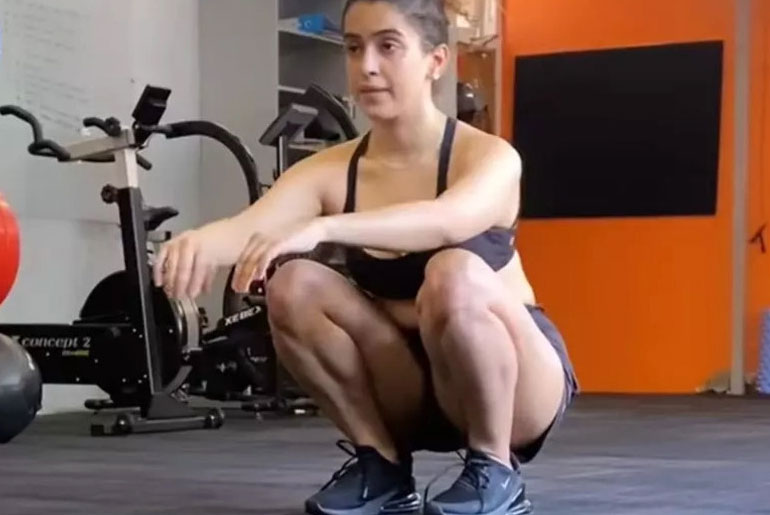Sanya Malhotra’s latest Instagram video showcases her impressive fitness dedication as she performs an advanced balancing routine on a wooden balance board. Under the guidance of her fitness coach, she maintains balance on one leg with a brick placed on her raised leg, while her coach adds a humorous twist with a ‘bumblebee dance’ in the background. This demonstration not only highlights her strength and control but also emphasizes the benefits of incorporating balance training into any fitness regimen.
Why Balance Training is Important
Health and fitness expert Ishvinder Singh Sodhi explains that balance training significantly improves reaction time, which is essential for professional athletes. This enhanced ability allows athletes to respond quickly and accurately, facilitating faster movements like catching and throwing a ball, changing direction, and managing physical impacts during sports activities.
Dr. Vajalla Shravani, a senior physiotherapist and certified Pilates trainer at Tone 30, adds that balance exercises improve postural alignment and body awareness. This leads to better functional movement in daily activities. Through balance training, individuals enhance their proprioception—an understanding of their body’s position in space—resulting in improved coordination.
Role of Balance Exercises in Injury Prevention
According to Dr. Shravani, balance exercises are crucial for preventing injuries by strengthening the stabilizing muscles around key joints, particularly the ankles, knees, and hips. These muscles are essential for maintaining joint stability and preventing injuries such as ankle sprains or knee injuries that can occur during sudden movements.
Regular practice of balance exercises conditions these stabilizing muscles to react quickly and effectively, thereby reducing the risk of lower body injuries. This aspect is particularly advantageous for individuals engaged in sports or high-impact activities, as balance training enhances the body’s resilience against destabilizing forces.
Enhancing Core Strength through Balance Training
Sodhi highlights that with the rise of desk jobs, spine and cervical-related issues are increasingly common. Traditional exercises like crunches and sit-ups may worsen existing problems, making core balance training a preferable option. Core balance exercises strengthen the core without placing undue strain on the spine, offering a safer and equally effective alternative to conventional abdominal exercises.
Engaging in core balance training improves overall physical resilience and coordination by activating multiple muscle groups. This not only enhances balance but also supports efficient movement patterns, contributing to overall well-being and a decreased risk of chronic pain. Regular practice of core balance training can enhance athletic performance and functional abilities in daily life. It promotes mindful movement and body awareness, allowing for greater control and fluidity in motion.
Sanya Malhotra’s impressive balancing act serves as a reminder of the significance of balance training in fitness. As emphasized by experts, incorporating balance exercises can lead to improved reaction times, injury prevention, enhanced core strength, and overall better functional movement. By prioritizing balance training, individuals can enjoy numerous physical benefits while minimizing the risk of injury, ultimately fostering a healthier and more active lifestyle.
Beginner-Friendly Balance Exercises
Incorporating balance exercises into your fitness routine can significantly enhance stability and coordination. Here are some practical exercises recommended by Dr. Shravani that are perfect for beginners:
1. Single-Leg Balance
- How to do it: Stand on one leg for 20-30 seconds, ensuring you maintain a straight posture.
- Progression: As you become more comfortable, increase the duration or try balancing on an unstable surface, such as a pillow, to further challenge your stability.
2. Heel-to-Toe Walk
- How to do it: Walk in a straight line, placing one foot directly in front of the other, so that the heel of one foot touches the toes of the other.
- Benefits: This simple exercise improves stability and coordination in the lower body.
3. Balance on a Stability Ball
- How to do it: Sit on a stability ball with your feet flat on the ground. Lift one foot off the floor while maintaining your balance.
- Benefits: This exercise engages your core and challenges your balance, helping to enhance overall stability.
4. Wall Pilates Exercises
- How to do it: Utilize a wall for support while performing Pilates exercises. Movements such as wall sits and leg lifts against the wall can be beneficial.
- Benefits: Wall Pilates provides a gentle introduction to balance work, promoting stability and core strength while using the wall for additional support.
These beginner-friendly balance exercises are effective for enhancing stability, improving coordination, and building core strength. Incorporating them into your fitness routine can contribute to overall physical resilience and reduce the risk of injuries. Start slow and gradually progress to more challenging variations as your balance improves!
Disclaimer:
The information contained in this article is for educational and informational purposes only and is not intended as a health advice. We would ask you to consult a qualified professional or medical expert to gain additional knowledge before you choose to consume any product or perform any exercise.








